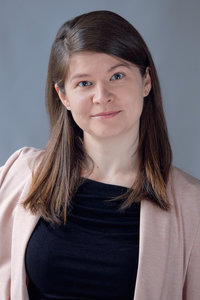


Address:
Institute of Geological Sciences, Polish Academy of Sciences
Research Centre in Warsaw
Twarda 51/55, 00-818 Warsaw, Poland
Position: Assistant Professor
E-mail: ndgiera@cyf-kr.edu.pl
Research interests:
isotope geochemistry, minerals of the apatite group, secondary ion mass spectrometry, reference materials development
Education:
2014–2020: PhD in the field of Exact Sciences and Natural Sciences, in the discipline of Earth and Environmental Sciences at the Institute of Geological Sciences PAS, Warsaw
2013–2014: MSc. in Mining and Geology at the AGH University of Science and Technology in Cracow
2009–2013 - BSc. in Mining and Geology at the AGH University of Science and Technology in Cracow
Professional career:
Institute of Geological Sciences of the Polish Academy of Sciences, Research Centers in Cracow and Warsaw
Helmholtz Centre Potsdam, GFZ German Research Centre for Geosciences, Section 3.1. Inorganic and Isotope Geochemistry
Bureau for Forest Management and Geodesy in Cracow
Other activities and positions held:
Publications:
Grema H.M., Magnall J.M., Gleeson S.A., Milton J.E., Wudarska A., Schleicher A.M., Schulz H-M. Mineralogy and paragenesis of the Boundary Zone Zn-Pb±Ag prospect, Yukon, Canada. Economic Geology (in press).
Research projects:
Development of new reference materials for boron and sulphur isotope analyses of apatite
Minerals of the apatite group can incorporate minor or trace amounts of sulphur and boron in their crystal structure, making them useful isotope archives with a special focus on biogenic materials. The aim of this project is to develop homogeneous, well-characterized reference materials for sulphur (δ34SVCDT) and boron (δ11BSRM951) isotope measurements to enable high-quality in situ investigations, expanding SIMS and LA-ICP-MS methods applications to a wide range of paleoenvironmental and (paleo)ecological studies of vertebrate inorganic tissues. This project takes advantage of existing apatite specimens that are available in large amounts, and therefore, when fully characterised for δ34S or δ11B data calibration would last for many years to come.
Team members: Alicja Wudarska (Principal Investigator) |
Michael Wiedenbeck (GFZ, Potsdam, Germany), Frédéric Couffignal (GFZ, Potsdam, Germany), Johannes Glodny (GFZ, Potsdam, Germany). |
Determination of the relative age of fossil teeth using the fluorine dating method
The main component of teeth and bone is hydroxylapatite Ca10(PO4,CO3)6(OH,CO3)2 , whose chemical and isotopic composition is an important indicator in paleoenvironmental studies. The structure of apatite allows numerous isomorphic substitutions, and its composition may be altered after deposition in sediment. One of the transformation processes of bioapatite is F– substitutions in the (OH)– position, the quantification of which has been used in the past to determine the age of fossil bones. However, due to the complex crystallochemistry of apatite and complex sub-deposition processes, a number of problems have been identified in the interpretation of results not only when comparing samples from different locations, but also within a single site. With the development of research methods used in the reconstruction of palaeoenvironments, infrared spectroscopy (FTIR) and Raman microscopy have become increasingly important as tools for assessing the degree of diagenetic alteration of fossils (e.g. by determining CI crystallinity and C/P ratio). The main goal of this research is to test suitability of both methods for determining the age of fossil teeth based on the F contents in their structure.
Team members: Alicja Wudarska (Project Coordinator), Maciej Krajcarz (LIS), Małgorzata Lempart (ClayLab), Anna Mulczyk (LUT), | Magdalena Krajcarz (UMK, Toruń), Maciej Manecki (AGH, Kraków). |
Preliminary isotope study of fossils from the Cradle of Humankind caves, South Africa
Underground karst forms of the Bolt’s Farm located within the UNESCO World Heritage List Hominid Fossil Sites of South Africa World Heritage Site are being intensively explored by geologists and anthropologists searching for fossil material of Pliocene and Pleistocene fauna and, most importantly, archaic human species. A goal of our preliminary study is to asses the suitability of oxygen isotope analysis by SIMS and GS-IRMS as well as spectroscopic analysis using FTIR and Raman microscopy for the investigation of mammalian fossil teeth from the Bolts’ Farm.
Team members: Alicja Wudarska (Project Coordinator), Maciej Krajcarz (LIS), Małgorzata Lempart (ClayLab), |
Michael Wiedenbeck (GFZ, Potsdam, Germany), Jan Kramers (University of Johannesburg, S Africa), Tebogo Makhubela (University of Johannesburg, S Africa), Dominique Gommery (Sorbonne Université, Paris), Lazarus Kgasi (Ditsong National Museum of Natural History, Pretoria), Loïc Segalen (Sorbonne Université, Paris), Nonny Vilakazi (University of Johannesburg), Maciej Manecki (AGH, Cracow). |
Development of the reference material(s) for U-Pb dating of apatite
Minerals of the apatite group commonly incorporate trace amounts of uranium into their structure. Due to the different closure temperature of the U-Pb system for apatite, it can complement zircon or it may serve as the sole way of the age determination of rocks. In cases, where limited amount of the material is available, the in situ analysis using SIMS is the method of choice. However, SIMS is hampered by the lack of homogeneous apatite reference materials, and therefore, the goal of our project is to develop new, well-characterized reference material(s) for U-Pb dating of apatite.
Team members: Alicja Wudarska (Principal Investigator), Ewa Słaby (PetroGen), |
Michael Wiedenbeck (GFZ, Potsdam, Germany), Frédéric Couffignal (GFZ, Potsdam, Germany), Johannes Glodny (GFZ, Potsdam, Germany) Sarah Glynn (University of the Witwatersrand, Johannesburg, S Africa). |
Development of new reference materials for oxygen isotope analysis and U-Pb dating of apatite
Variation of isotope ratios in early Archaean apatites as a source of information on the origin of water/ volatiles on the Earth
Research scholarships:
Awards:
Conference contributions:
Updated on 24 Sept 2024